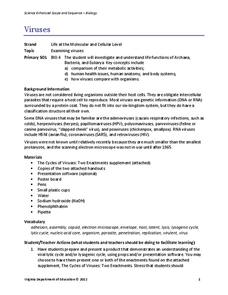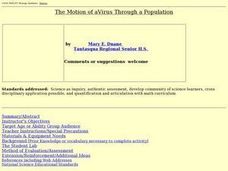Virginia Department of Education
Viruses
Germs, parasites, and viruses, oh my! Facilitate a instructional activity on viruses as individuals explore functions of Archaea, Bacteria, and Eukarya. They learn how viruses compare with other organisms in nature and how they...
Curated OER
Bioterrorism: Development of a "Superbug"
Students compare bacteria and viruses and their roles in biotechnology and bioterrorism. They outline fundamental steps of bacterial transformation and the possible selection processes to identify transformants. They discuss...
Curated OER
Evolution of the Virus: Teaching Macroevolution Through Microevolution
Students describe the anatomy of a virus. In this biology lesson, students compare and contrast the characteristics of bacteria and viruses. They discover the genetic adaptations of viruses over time.
Cornell University
Bacteria Take Over and Down
Bacteria outnumber all other forms of life on Earth. Scholars observe the growth of bacteria in petri dishes to understand their role in maintaining good health. Then, they observe the growth of bacteria after they introduce...
Curated OER
Biology - Virus Modeling
Students research one of the many types of viruses. They create a 3-D model of the virus they researched with graphics software.
Curated OER
The Motion of a Virus Through a Population
Students test the factors that influence the rate at which a virus spreads through a population. They complete a lab activity then discuss data collected and review and answer a set of questions.
Curated OER
Ah Choo!
Middle schoolers compare bacteria to viruses to find the differences. For this biology lesson, students research viruses they have been inoculated against, using the Internet. Middle schoolers complete a graphic organizer of their...
Centers for Disease Control and Prevention
Teach Mrs. Jones' Class about Microbes
During a biology lesson, scholars research microbes, design a lesson plan using an outline, and present the lesson to the class.
Children’s Hospital of Philadelphia
Case Study: The 1918 Influenza Pandemic – Factors Beyond the Biological that Influence the Spread of Disease
A very timely instructional activity looks at the social and political factors that affect the spread of disease. Using the 1918 Influenza Pandemic as a case study, pupils research factors that influenced the spread of the disease,...
Creative Learning Exchange
The Infection Game: The Shape of Change
Encourage the spread of knowledge in your class with this cross-curricular epidemic simulation. Pulling together science, social studies, and math, this lesson engages students in modeling the spread of infectious diseases, collecting...
Curated OER
Arctica - An Interactive Mystery
Rumours of illness, poisoning, and madness - a ship disappears without a trace! Read this interactive science story and use deductive reasoning skills to solve a mystery. This engaging resource gives science stars a chance to practice...
Curated OER
Investigating the Method by Which the Body Defends Against Pathogens
High schoolers explore disease caused by bacteria and viruses, how they are transmitted, and how they exert their effects on their hosts. They explain how diseases, such as AIDS, are spread by exponential growth.
Curated OER
Antibodies
Students conduct a series of exploration activity on how vaccines and antibodies work. In this biology lesson, students test how antigens and antibodies work in the body. They discuss the benefits of vaccines in promoting immune responses.
Curated OER
Plankton / Phytoplankton
Students discuss the importance of plankton in the ocean ecosystem. In this biology activity, students identify the different types plankton by observing them under the microscope. They explain how plankton population affect global climate.
Curated OER
Classify the Microbes
Young scholars classify microorganisms into categories based on their characteristics. Pupils use a taxonomic key to identify organisms. They classify certain bacteria, protists, and viruses using a classification or taxonmic key.
Curated OER
Infectious Diseases: Hepatitis B and Tuberculosis
Students discover the different sources of pathogens that cause diseases. In this health science lesson, students explore different ways to treat infections. They create a persuasive pamphlet on their position on vaccination.
Curated OER
Body Battles!
Seventh graders explain the role of white blood cells in fighting infections. In this life science lesson, 7th graders create flow charts showing the immune response process. They act out and play a game to simulate actions of the immune...
Curated OER
Pandemics
Young scholars demonstrate their knowledge of past, present and future pandemics. They create timeline for the spread of Influenza Pandemic of 1918. They discuss parallels between outbreaks of influenza and bird flu.
Curated OER
What happens to water before we use it?
Learners examine how water is treated prior to becoming available for human consumption. In this water treatment lesson plan, students conduct an experiment in which they filter water. Learners formulate a hypothesis, test, analyze data,...
Curated OER
Life in the Crystal Palace
Marine biologists research sea ice communities. Assign some groups to construct paper models of sea ice communities in winter, and some to construct models of them in summer. The lesson is simplistic, but the Internet resources provided...





















